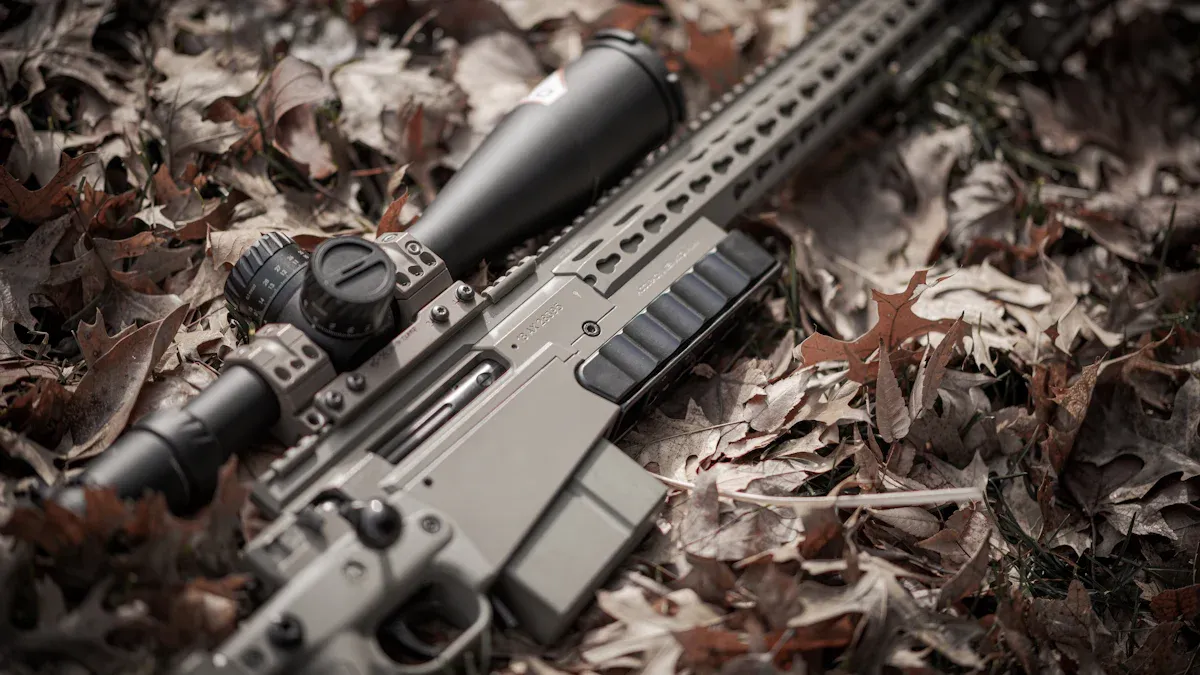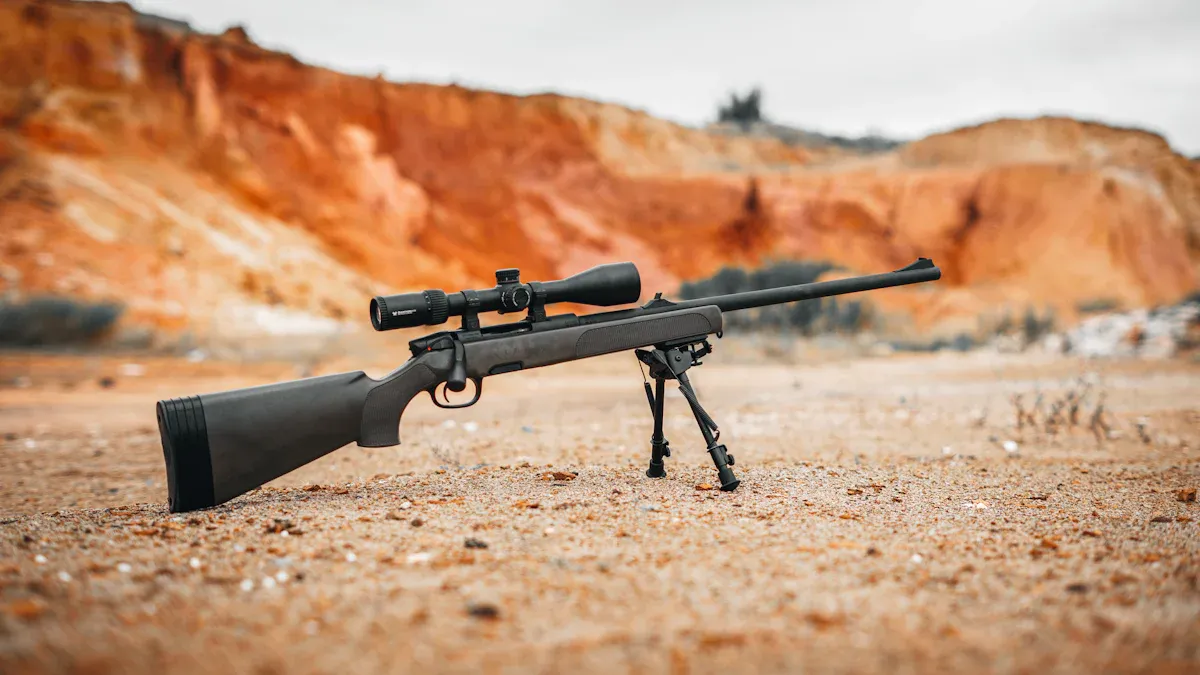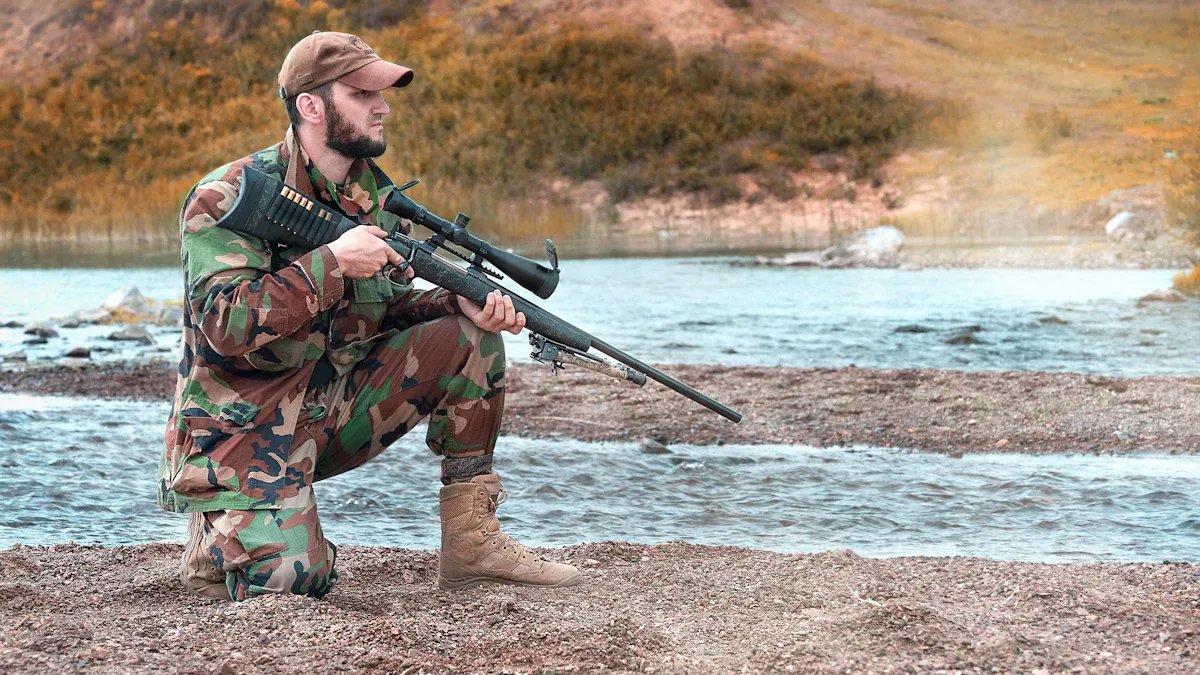
A rifle bipod transforms shooting accuracy by stabilizing the firearm and reducing recoil. Adjustable legs adapt to different terrains, while compatible mounts ensure seamless integration with accessories like a rifle scope. Lightweight designs reduce fatigue during long sessions. Choosing the right bipod enhances performance, whether shooting prone or navigating obstacles with a rail system.
Key Takeaways
- A small rifle bipod helps keep the gun steady and accurate. It lets shooters aim better and shoot more precisely.
- Choose one with legs you can adjust and that is light. This makes it easy to carry and use in different places.
- Check and clean your bipod often to keep it working well. This will make it last longer and stay dependable.
Why a Compact Tactical Rifle Bipod Matters

Enhancing Stability and Accuracy
A compact tactical rifle bipod plays a vital role in improving shooting stability and accuracy. By providing a solid platform, it minimizes movement caused by body sway or recoil, allowing shooters to focus on their aim and trigger control. This stability is especially critical in long-range shooting, where even slight deviations can result in missed targets. Shooters often report increased confidence when using a bipod, as it helps them maintain better technique and mental clarity during high-pressure situations.
- Many top shooters favor the Harris bipod for its reliability and effectiveness. Its design reduces recoil "hop," ensuring better shot visibility.
- Stability also enhances precision, making it easier to achieve consistent results across different shooting sessions.
Portability for Tactical Scenarios
Portability is a game-changer in tactical situations. Compact bipods are designed with features like quick-deploy mechanisms and adjustable leg lengths, making them easy to carry and set up. These innovations ensure shooters can adapt quickly to changing environments without sacrificing stability.
Research highlights the practicality of lightweight bipods like the MDT Ckye-Pod, which weighs 5 to 6 ounces less than alternatives while maintaining versatility. This makes it ideal for scenarios requiring mobility, such as competitive shooting or field operations. Shooters appreciate how these bipods attach securely to various rail systems, ensuring readiness for immediate action.
Adapting to Different Shooting Environments
Compact tactical rifle bipods excel in diverse shooting conditions. Their adjustable legs and versatile designs allow them to adapt to uneven terrains, prone positions, or elevated platforms. This flexibility ensures shooters can maintain stability and accuracy regardless of the environment.
| Feature | Description |
|---|---|
| Increased Stability | Provides a stable shooting platform, reducing the effects of body movement and recoil. |
| Improved Accuracy | Helps shooters achieve more precise and consistent shots by stabilizing the firearm. |
| Reduced Fatigue | Takes the weight off the shooter’s arms, reducing fatigue during extended shooting sessions. |
| Versatility | Adjustable bipods can be used in various shooting positions and terrains, making them versatile for different shooting scenarios. |
Whether hunting in rugged terrain or competing in tactical matches, a compact bipod ensures shooters stay prepared and perform at their best.
Key Features to Look For

Leg Length and Adjustability
A good rifle bipod should offer adjustable leg lengths to suit different shooting positions. Whether shooting prone, kneeling, or on uneven terrain, adjustable legs provide the flexibility needed for stability. Some models feature quick-deploy mechanisms, allowing shooters to set up in seconds. Longer legs can improve shooting positions but may add extra weight, so finding the right balance is key.
Attachment Types (e.g., Quick Detach, Picatinny Rail Compatibility)
Attachment options play a big role in compatibility. Many modern bipods use quick-detach systems, making it easy to attach or remove them without tools. Picatinny rail compatibility is another popular feature, ensuring the bipod fits securely on most tactical rifles. Shooters should check their rifle’s mounting system to choose a bipod that integrates seamlessly.
Weight and Portability
Weight and portability are critical for shooters who move frequently. Lightweight bipods, like the MDT Ckye-Pod Lightweight Single Pull, reduce fatigue during long sessions while maintaining stability. However, lighter models may sacrifice some sturdiness. Shooters should consider how far they’ll carry their rifle bipod and whether they need a balance between weight and stability.
Material and Durability
Durability depends on the materials used. Aluminum and carbon fiber are common choices, offering strength without excessive weight. Aluminum provides excellent durability, while carbon fiber is lighter but still robust. A durable bipod ensures reliable performance in harsh conditions, from rain to rugged terrain.
Swivel and Tilt Capabilities
Swivel and tilt features add versatility to a rifle bipod. These allow shooters to adjust the rifle for uneven ground, ensuring a level shot. Modern designs often include canting, which helps stabilize the firearm for precise shots. This flexibility is especially useful for long-range accuracy and adapting to various shooting environments.
Top Use Cases and Recommendations
Long-Range Precision Shooting
Long-range shooting demands precision, and a stable platform is key. Bipods provide the support needed to minimize movement and maintain accuracy over distances of 300 to 1000 yards. Shooters in the Precision Rifle Series (PRS) often rely on bipods for their ability to handle recoil and improve target spotting.
- Why it works: Stability enhances precision and consistency, which are vital for hitting small targets.
- Popular choice: The Harris S-BRM 6-9” Notched Bipod is a favorite among PRS competitors. Its notched legs and swivel capabilities allow shooters to adjust for uneven terrain, making it ideal for prone shooting.
Austin Orgain, a two-time PRS Champion, shared: "I’m just an old fogey and run the ol’ Harris bipod with the Really Right Stuff arca adapter on it. There are certain matches where you have a lot of terrain that you have to deal with, and at that point, I run an MDT Ckye-Pod bipod."
Hunting in Rugged Terrain
Hunters often face unpredictable environments, from rocky hills to dense forests. A bipod helps stabilize the rifle, reducing fatigue during long waits and improving accuracy for ethical shots.
- Why it works: Adjustable legs adapt to uneven ground, while lightweight designs make them easy to carry.
- Field-tested gear: The MDT Ckye-Pod Lightweight Bipod proved its worth during a bighorn sheep hunt in Alberta. Its versatility and stability allowed the hunter to focus on the target without worrying about terrain challenges.
Tactical and Competitive Shooting
In tactical and competitive settings, speed and adaptability are crucial. Bipods with quick-deploy mechanisms and swivel features give shooters an edge by allowing rapid adjustments.
- Why it works: A stable shooting platform improves accuracy and consistency, even under pressure.
- Top pick: The MDT Ckye-Pod Double-Pull Bipod stands out for its versatility. Shooters appreciate its ability to handle diverse scenarios, from urban tactical matches to high-stakes competitions.
Example Recommendations for Each Use Case
Here’s a quick guide to choosing the right bipod for your needs:
| Use Case | Recommended Bipod | Key Features |
|---|---|---|
| Long-Range Precision Shooting | Harris S-BRM 6-9” Notched Bipod | Notched legs, swivel capabilities, prone use |
| Hunting in Rugged Terrain | MDT Ckye-Pod Lightweight Bipod | Lightweight, adjustable legs, durable design |
| Tactical/Competitive Shooting | MDT Ckye-Pod Double-Pull Bipod | Quick-deploy, versatile, handles tough terrain |
Whether you’re competing, hunting, or practicing precision shooting, the right bipod can make all the difference.
How to Test and Maintain Your Rifle Bipod
Testing Stability and Adjustability
Testing a bipod’s stability and adjustability ensures it performs well in the field. Shooters should start by mounting the bipod securely on their rifle and verifying that it stays firmly in place. Extending the legs fully and checking for smooth operation is essential. Both legs should lock into position without wobbling.
To test stability, place the bipod on a flat surface and apply gentle pressure to the rifle. If the legs shift or the mount feels loose, adjustments may be necessary. For uneven terrain, ensure the legs adjust independently and maintain balance. Regular testing helps identify potential issues before they affect performance.
Cleaning and Lubrication Tips
Dirt and debris can hinder a bipod’s functionality. After each use, shooters should clean the bipod thoroughly. A soft cloth works well for wiping down the legs and removing grime. For moving parts, a small amount of lubricant keeps them operating smoothly. Avoid over-lubricating, as excess oil can attract dirt.
Tip: Use a silicone-based lubricant for metal components to prevent rust and ensure long-lasting performance.
Inspecting for Wear and Tear
Routine inspections help catch early signs of wear. Shooters should:
- Check for loose connections or screws.
- Verify that the legs extend and lock properly.
- Ensure the bipod mounts securely to the rifle.
- Look for visible damage, such as cracks or bent parts.
If stability issues persist, inspect both legs to confirm they are the same length and firmly planted. Addressing these problems promptly prevents further damage.
Storing Your Bipod for Longevity
Proper storage extends a bipod’s lifespan. Keep it in a dry, cool place to avoid rust or corrosion. A protective case adds an extra layer of safety, shielding the bipod from accidental damage. Avoid storing it in extreme temperatures, as this can weaken materials over time.
| Storage Solution | Description |
|---|---|
| Store in a Dry Place | Keep your bipod in a dry, cool place to prevent rust and corrosion. |
| Use a Protective Case | Store your bipod in a protective case or cover to prevent damage. |
| Avoid Extreme Temperatures | Do not store your bipod in extreme temperatures, affecting its materials. |
| Maintain Your Bipod | Keep your bipod clean and well-maintained to ensure longevity. |
By following these steps, shooters can ensure their bipod remains reliable for years to come.
Choosing the right bipod can make a huge difference in shooting performance. Features like adjustability, weight, and durability ensure it meets specific needs. Regular testing and maintenance keep it reliable for years. Whether for hunting or tactical use, a well-maintained bipod helps shooters stay confident and ready for any challenge.
Post time: Mar-24-2025
